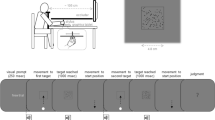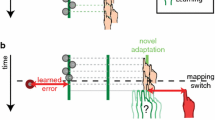Abstract
The present study tested whether the coupling of covert attentional shifts and motor planning of pointing movements can be modulated by learning. Participants performed two tasks. As a primary movement task, they executed a pointing movement to a movement target (MT) location. As a secondary visual attention task, they identified a discrimination target (DT) that was presented shortly before initiation of the pointing movement. These DTs either occurred at the same or at different locations with the MT. A common finding in such and similar settings is the enhanced visual target identification when locations of MT and DT coincide. However, it is not known which factors govern the flexibility of spatial attention–action coupling. Here, we tested the influence of previously learned spatial contingencies between MT and DT on the coupling of covert attention and motor planning. These contingencies were manipulated in three groups (always same locations, always opposite locations, non-contingent locations) in a training session. Results indicated that in a subsequent test phase, previously learned contingencies enhanced visual identification accordingly, even when targets for the movement task and the visual task were presented at opposite sides. These results corroborate previous findings of a rather flexible interaction of attention and motor planning, and demonstrate how one can learn to control attention by means of motor planning.


Similar content being viewed by others
References
Astafiev, S. V., Shulman, G. L., Stanley, C. M., Snyder, A. Z., van Essen, D. C., & Corbetta, M. (2003). Functional organization of human intraparietal and frontal cortex for attending, looking, and pointing. Journal of Neuroscience, 23, 4689–4699.
Baldauf, D., & Deubel, H. (2010). Attentional landscapes in reaching and grasping. Vision Research, 50, 999–1013.
Baldauf, D., Wolf, M., & Deubel, H. (2006). Deployment of visual attention before sequences of goal-directed hand movements. Vision Research, 46, 4355–4374.
Bressler, S. L., Tang, W., Sylvester, C. M., Shulman, G. L., & Corbetta, M. (2008). Top-down control of human visual cortex by frontal and parietal cortex in anticipatory visual spatial attention. Journal of Neuroscience, 28, 10056–10061.
Chun, M. M., & Jiang, Y. (1999). Top-down attentional guidance based on implicit learning of visual covariation. Psychological Science, 10, 360–365.
Chun, M. M., & Jiang, Y. (2003). Implicit, long-term spatial contextual memory. Journal of Experimental Psychology: Learning, Memory, and Cognition, 29, 224–234.
Collins, T., Schicke, T., & Röder, B. (2008). Action goal selection and motor planning can be dissociated by tool use. Cognition, 109, 363–371.
Corbetta, M. (1998). Frontoparietal cortical networks for directing attention and the eye to visual locations: Identical, independent, or overlapping neural systems?. Proceedings of the National Academy of Sciences, 95(3), 831–838.
Corbetta, M., Kincade, J. M., Ollinger, J. M., McAvoy, M. P., & Shulman, G. L. (2000). Voluntary orienting is dissociated from target detection in human posterior parietal cortex. Nature Neuroscience, 3, 292–297.
Craighero, L., Fadiga, L., Rizzolatti, G., & Umiltà, C. (1999). Action for perception: A motor-visual attentional effect. Journal of Experimental Psychology: Human Perception and Performance, 25, 1673–1692.
Deubel, H., & Schneider, W. X. (1996). Saccade target selection and object recognition: Evidence for a common attentional mechanism. Vision Research, 36, 1827–1837.
Deubel, H., & Schneider, W. X. (2003). Delayed saccades, but not delayed manual aiming movements, require visual attention shifts. Annals of the New York Academy of Sciences, 1004(1), 289–296.
Deubel, H., & Schneider, W. X. (2004). Attentional selection in sequential manual movements, movements around an obstacle and in grasping. In G. W. Humphreys & M. J. Riddoch (Eds.), Attention in Action (pp. 69–91). Hove (2004): Psychology Press.
Dore-Mazars, K., Pouget, P., & Beauvillain, C. (2004). Attentional selection during preparation of eye movements. Psychological Research Psychologische Forschung, 69, 67–76.
Fagioli, S., Hommel, B., & Schubotz, R. I. (2007). Intentional control of attention: Action planning primes action-related stimulus dimensions. Psychological Research Psychologische Forschung, 71(1), 22–29.
Fan, J., McCandliss, B. D., Sommer, T., Raz, A., & Posner, M. I. (2002). Testing the efficiency and independence of attentional networks. Journal of Cognitive Neuroscience, 14, 340–347.
Fecteau, J. H., Bell, A. H., & Munoz, D. P. (2004). Neural correlates of the automatic and goal-driven biases in orienting spatial attention. Journal of Neurophysiology, 92, 1728–1737.
Gherri, E., & Eimer, M. (2009). Manual response preparation disrupts spatial attention: An electrophysiological investigation of links between action and attention. Neuropsychologia, 48, 961–969.
Gottlieb, J., Balan, P. F., Oristaglio, J., & Schneider, D. (2009). Task specific computations in attentional maps. Vision Research, 49, 1216–1226.
Hoffman, J. E., & Subramaniam, B. (1995). The role of visual attention in saccadic eye movements. Perception and Psychophysics, 57, 787–795.
Hoffmann, J., & Kunde, W. (1999). Location-specific target expectancies in visual search. Journal of Experimental Psychology: Human Perception and Performance, 25, 1127–1141.
Hoffmann, J., & Sebald, A. (2005). Local contextual cuing in visual search. Experimental Psychology, 52, 31–38.
Huestegge, L., & Adam, J. J. (2011). Oculomotor interference during manual response preparation: Evidence from the response cueing paradigm. Attention, Perception, and Psychophysics, 73, 702–707.
Huestegge, L., & Koch, I. (2010). Fixation disengagement enhances peripheral perceptual processing: Evidence for a perceptual gap effect. Experimental Brain Research, 201, 631–640.
Huestegge, L., & Kreutzfeldt, M. (2012). Action effects in saccade control. Psychonomic Bulletin and Review, 19, 198–203.
Huestegge, L., Pieczykolan, A., & Koch, I. (2014). Talking while looking: On the encapsulation of output system representations. Cognitive Psychology, 73, 73–91.
Humphreys, G. W., & Riddoch, M. J. (2005). Attention in Action: Advances from Cognitive Neuroscience. Hove: Psychology Press.
Jonikaitis, D., & Deubel, H. (2011). Independent allocation of attention to eye and hand targets in coordinated eye-hand movements. Psychological Science, 22(3), 339–347.
Jonikaitis, D., Schubert, T., & Deubel, H. (2010). Preparing coordinated eye and hand movements: dual-task costs are not attentional. Journal of Vision, 10(14), 23–23.
Khan, A. Z., Blangero, A., Rossetti, Y., Salemme, R., Luaute, J., Deubel, H., & Pisella, L. (2009). Parietal damage dissociates saccade planning from presaccadic perceptual facilitation. Cerebral Cortex, 19, 383–387.
Khan, A. Z., Song, J. H., & McPeek, R. M. (2011). The eye dominates in guiding attention during simultaneous eye and hand movements. Journal of Vision, 11(1), 9–9.
Klapetek, A., Jonikaitis, D., & Deubel, H. (2016). Attention allocation before antisaccades. Journal of Vision, 16(1), 11–11.
Koch, C., & Ullman, S. (1985). Shifts in selective visual attention: towards the underlying neural circuitry. Hum. Neurobiol., 4, 219–227.
Kowler, E., Anderson, E., Dosher, B., & Blaser, E. (1995). The role of attention in the programming of saccades. Vision Research, 35, 1897–1916.
Li, H. H., Barbot, A., & Carrasco, M. (2016). Saccade preparation reshapes sensory tuning. Current Biology, 26(12), 1564–1570.
Miller, J. (1988). Components of the location probability effect in visual search tasks. Journal of Experimental Psychology: Human Perception and Performance, 14, 453–471.
Moehler, T., & Fiehler, K. (2014). Effects of spatial congruency on saccade and visual discrimination performance in a dual-task paradigm. Vision Research, 105, 100–111.
Montagnini, A., & Castet, E. (2007). Spatiotemporal dynamics of visual attention during saccade preparation: Independence and coupling between attention and movement planning. Journal of Vision, 7, 1–16.
Moore, T., & Fallah, M. (2001). Control of Eye Movements and Spatial Attention. Proceedings of the National Academy of Sciences, 98, pp. 1273–1276.
Musen, G. (1996). Effects of task demands on implicit memory for object-location associations. Canadian Journal of Experimental Psychology, 50, 104–113.
Rizzolatti, G., & Craighero, L. (1998). Spatial Attention: Mechanisms and Theories. In M. Sabourin, F. Craik & M. Robert (Eds.), Advances in Psychological Science: Vol.2. Biological and Cognitive Aspects (pp. 171–198). East Sussex: Psychology Press.
Rizzolatti, G., & Craighero, L. (2010). Pre-motor theory of attention. Scholarpedia, 5, 6311.
Rizzolatti, G., Riggio, L., Dascola, I., & Umiltá, C. (1987). Reorienting attention across the horizontal and vertical meridians: evidence in favor of a pre-motor theory of attention. Neuropsychologia, 25, 31–40.
Schneider, W., Eschman, A., & Zuccolotto, A. (2002). E-prime user’s guide. Pittsburgh: Psychology Software Tools Inc.
Smith, D. T., & Schenk, T. (2012). The premotor theory of attention: time to move on? Neuropsychologia, 50(6), 1104–1114.
Song, J. H., & McPeek, R. M. (2009). Eye-hand coordination during target selection in a pop-out visual search. Journal of Neurophysiology, 102(5), 2681–2692.
Stewart, E. E., & Ma-Wyatt, A. (2015). The spatiotemporal characteristics of the attentional shift relative to a reach. Journal of vision, 15(5), 10–10.
Striemer, C., Locklin, J., Blangero, A., Rossetti, Y., Pisella, L., & Danckert, J. (2009). Attention for action? Examining the link between attention and visuomotor control deficits in a patient with optic ataxia. Neuropsychologia, 47, 1491–1499.
Thompson, K. G., & Bichot, N. P. (2005). A visual salience map in the primate frontal eye field. Progress in Brain Research, 147, 251–262.
Tipper, S. P., Lortie, C., & Baylis, G. C. (1992). Selective reaching: Evidence for action-centered attention. Journal of Experimental Psychology Human Perception and Performance, 18, 891–891.
Wykowska, A., Schubö, A., & Hommel, B. (2009). How you move is what you see: action planning biases selection in visual search. Journal of Experimental Psychology: Human Perception and Performance, 35(6), 1755–1769.
Author information
Authors and Affiliations
Corresponding author
Ethics declarations
Conflict of interest
The authors declare that they have no conflict of interest.
Ethical standards
All procedures performed in studies involving human participants were in accordance with the ethical standards of the institutional and/or national research committee, and with the 1964 Helsinki declaration and its later amendments or comparable ethical standards.
Informed consent
Informed consent was obtained from all individual participants included in the study.
Additional information
Publisher’s Note
Springer Nature remains neutral with regard to jurisdictional claims in published maps and institutional affiliations.
Data, analysis scripts and e-prime files can be retrieved from the Open Science Framework: https://osf.io/73bak/?view_only=01a3fb2e4e6c45ad872afe58fc053bb4.
Rights and permissions
About this article
Cite this article
Dignath, D., Herbort, O., Pieczykolan, A. et al. Flexible coupling of covert spatial attention and motor planning based on learned spatial contingencies. Psychological Research 83, 476–484 (2019). https://doi.org/10.1007/s00426-018-1134-0
Received:
Accepted:
Published:
Issue Date:
DOI: https://doi.org/10.1007/s00426-018-1134-0




